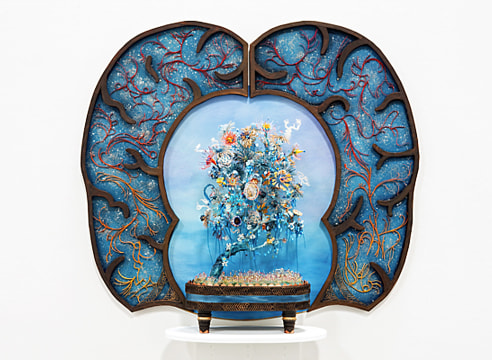Work Study Eowyn WilcoxSeptember 23, 2010
The Fantastical and the Real
Nancy Jackson's work embodies the fantastical, but in her most recent show I wasn't thinking in any way of modern fairytales which skip the difficult parts of life, but of old, ancient fairytales, the kind that A.S. Byatt talks about in The Children's Book as being dangerous. The kind of fairytales the Grimm brothers collected, and that most parents won't read to their children because fairytales like these are really meant for adults.
And at the same time, Nancy Jackson's work also reminds me of Emily Dickinson's poetry, because it is fierce, lonely, and exultant in its loneliness. All through her show I was amazed by the sense that I had never seen anything like this before, and that all this was sincere, real, the inner workings of not just any artist's dreamlife, but Nancy Jackson's particular and peculiar dreamlife, laid out with absolute honesty. Her cat-masks with their long whiskered chins were scary without being frightening, friendly but also sinister and dangerous. I had the sense, which occurs in the very best fairytales, the ones most sublime and at the same time most true to life, that I was fully enwrapped in her world, discovering that the mobiles spin at different rates when you move by them or breathe on them with some of the reflected power the artist must have felt at the same discovery. And on such a scale! Twenty-two feet from floor to ceiling, trailing whiskers and threads and white flower blossoms, and all without ever tipping out of the poetic intensity of the dream.
My favorite pieces in the show (along with the cat-masks) were the drawings, which were a revelation. They reminded me of Ensor's drawings in their intricacy, loneliness, and also in the scale and style of the work, but without his note of perversion. The skeletons in the drawings, the autumnal themes brought a note of death into the show which was deeply moving, and appropriate. It reminded me of what I was thinking about with the skull in Braque's studio---that all artists, to some extent or another, are making art to postpone their death, or to live on beyond death (to not be forgotten)---that they are, in fact, making art for or against death, in preparation for its coming. Death is an undercurrent in all art, just because it is either passing quicker than we are if the materials are ephemeral, or because we know it will last long after we die, if the materials are lasting. And at a deep level, art is a way that thought lives on even after the flesh decays. And I have to admit that the skeletons felt like something out of my dreams, because I used to dream often about skeletons throughout my childhood and adolescence. But I digress.
The Threesome gave me the thrill of the cat-faces again, in that it was something the likes of which I had never seen, and in which I instantly and implicitly believed. There was something about the emptiness of the room, the blurry city outside the windows, and the way the three ghosts seemed to describe three parts of the same process of disappearing: tears welling up on the left, invisibility in the middle, rock-like stoicism on the right.
What both artists reminded me of, and which I am grateful to both of them for, and which most great art makes me feel, is the sense that even though art is the most refined fantasy, still it teaches us deeply of the real, that it is in fact, deeply real, life distilled and intensified in an object or image.
